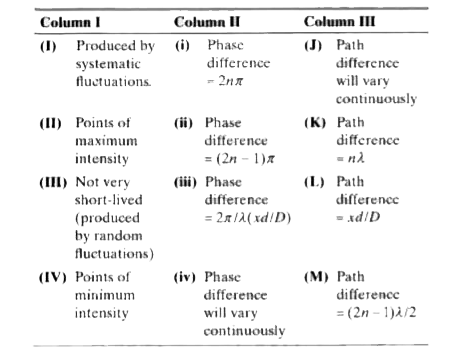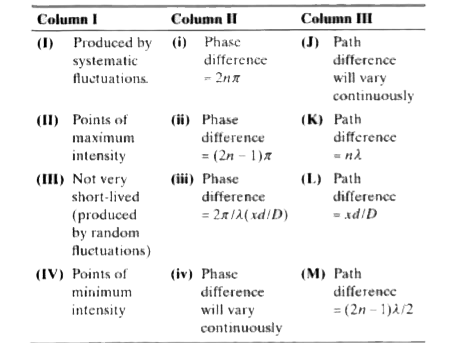Complete Solutions to PRACTICE QUESTIONS of chapter INTERFERENCE AND DIFFRACTION of Class 12 book with complete answers and questions
| Class 12 | PHYSICS |
| Chapter | INTERFERENCE AND DIFFRACTION |
| RESNICK AND HALLIDAY | PRACTICE QUESTIONS |
| Number Of Questions | 7 |
| Academic Year | 2023-24 |
Match the statements in Column I labeled as (a), (b), (c), and (d) with those in Column II labeled as (p), (q). (c), and (s). Any given statement in Column I can have correct matching with one or more statements in Column II.
Match the observation given in Column I with the experiments given in Column II.

View SolutionInterference is an important property of light. In the given table, Column I shows the properties of interfering waves, Column II shows the phase difference, and Column III shows the path difference between two interfering waves

What are the conditions for constructive interference?
View SolutionInterference is an important property of light. In the given table, Column I shows the properties of interfering waves, Column II shows the phase difference, and Column III shows the path difference between two interfering waves

What are the conditions for destructive interference?
View SolutionInterference is an important property of light. In the given table, Column I shows the properties of interfering waves, Column II shows the phase difference, and Column III shows the path difference between two interfering waves

What are the conditions for sustained interference?
View SolutionThe amplitudes of two coherent waves are vector quanti- ties. In the given table, Column I shows the phase differ ence between two coherent waves, Column II shows the path difference between them and Column III shows their resultant amplitudes.

When is the phasor diagram at primary maxima?
View SolutionThe amplitudes of two coherent waves are vector quanti- ties. In the given table, Column I shows the phase differ ence between two coherent waves, Column II shows the path difference between them and Column III shows their resultant amplitudes.

When is `E_(R)` maximum?
View SolutionThe amplitudes of two coherent waves are vector quanti- ties. In the given table, Column I shows the phase differ ence between two coherent waves, Column II shows the path difference between them and Column III shows their resultant amplitudes.

When is the phasor diagram at secondary maxima?
View Solution
PRACTICE QUESTIONS questions and complete solutions for chapter INTERFERENCE AND DIFFRACTION of RESNICK AND HALLIDAY PHYSICS (HINGLISH) of Class 12